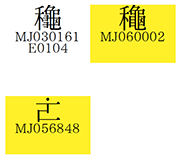 The Emoji Subcommittee (ESC) is on the front lines of Unicode emoji. It is responsible for accepting requests for new emoji and emoji sequences, helping requesters to fill out missing areas in their proposals, and providing prioritized recommendations to the Unicode Technical Committee.
The Emoji Subcommittee (ESC) is on the front lines of Unicode emoji. It is responsible for accepting requests for new emoji and emoji sequences, helping requesters to fill out missing areas in their proposals, and providing prioritized recommendations to the Unicode Technical Committee.Peter Edberg is stepping down as the co-chair of ESC, a role he has filled since its inception. He is one of the key people involved in Unicode emoji since the very beginning, so we are very lucky that he will continue as one of the technical leaders of ESC, and remain the co-author of “Unicode Emoji” (UTS #51). To ensure the smooth operation of the ESC, we have three eminently-qualified new vice-chairs: Jeremy Burge, who has been responsible for crafting and refining proposals from the most popular requests received at Emojipedia; Jennifer 8 Lee, who has played a pivotal role in developing, inspiring, and mentoring emoji requests through Emojination; and Tayfun Karadeniz, who has researched, organized, and shepherded emoji in the very popular areas of smileys and human-form emoji. All three have already made lasting contributions to the work of the ESC, and we welcome them in their new roles.
— Mark Davis, ESC chair
Over 100,000 characters are available for adoption, to
help the Unicode Consortium’s work on digitally disadvantaged languages.
![[fortune cookie badge]](http://www.unicode.org/announcements/ynh-fortune-cookie.png)
![[fortune cookie badge]](http://www.unicode.org/announcements/ynh-fortune-cookie.png)

![Unicode 10.0 Cover Art [Unicode 10.0 Cover Art]](http://www.unicode.org/announcements/uni10-pod-front.jpg) The Unicode 10.0 core specification is now available in paperback book form with a new, original cover design. This edition consists of a pair of modestly priced print-on-demand volumes containing the complete text of the core specification of Version 10.0 of the Unicode Standard.
The Unicode 10.0 core specification is now available in paperback book form with a new, original cover design. This edition consists of a pair of modestly priced print-on-demand volumes containing the complete text of the core specification of Version 10.0 of the Unicode Standard.

![cover art by Kosala Senevirathne [cover art by Kosala Senevirathne]](http://www.unicode.org/announcements/TUS10-Senevirathne-375px.jpg)
![submission by Diana Gomez [Diana Gomez]](http://www.unicode.org/announcements/TUS10-Gomez-200px.jpg)
![submission by Maitray Shah [Maitray Shah]](http://www.unicode.org/announcements/TUS10-Shah-200px.jpg)
 Emoji 6.0 is starting development, and initial drafts of the
Emoji 6.0 is starting development, and initial drafts of the ![[salad badge]](http://www.unicode.org/announcements/ynh-1f957-salad.png)
 The Unicode Consortium has posted a new issue for public review and comment.
The Unicode Consortium has posted a new issue for public review and comment.